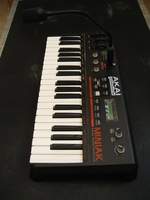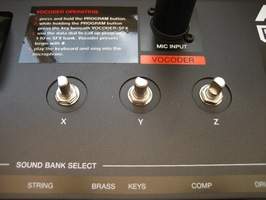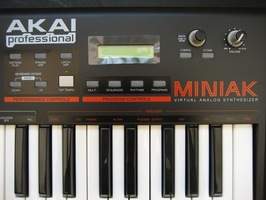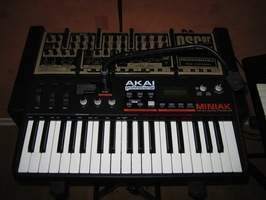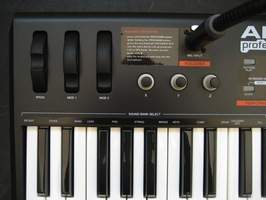After having repositioned Alesis on the market, Numark seems to have entrusted Akai with the fate of the synth/drum machine product range. The Miniak is the first Akai synth "in the modern era".
Late after the extinction of analog dinosaurs, musicians started to rediscover and revere these fat monsters. Manufacturers, which were developing preset-based digital workstations, decided to digitally model the behavior of analog circuitries. The last step was to conceive ergonomic user interfaces that included direct controls for a more authentic playing feel (to make the illusion more real, say analog fundamentalists). Very few manufacturers started to develop real programmable, polyphonic analog synths… One of the exceptions was Alesis who, against all odds, launched ten years ago the most powerful analog synth in history: Andromeda. This was a masterly achievement but also their deathblow: Numark bought the manufacturer in 2001, drastically reduced the Andromeda market price and launched a very successful range of analog modeling synths.
In 2003, the Ion provided eight voices of pure happiness with three powerful oscillators, two full-featured filters and a front panel fully packed with control elements. More affordable versions came out pretty fast: born in 2004, the Micron used the same sound synthesis as the Ion and even added effects to the rig, but it was hosted in a compact housing with reduced space for controls — not very ergonomic. Numark bought Akai Professional the same year and immediately redeployed the MPC product range. Now, they have introduced the Miniak: a Micron synth repacked under the Akai brand. So, the key question is: do they need cash and have relied on a tried and tested technology already amortized, or is it a strategic move to try to reposition the two brands? Anyway, people under 20 will think the Miniak is the first Akai analog synth. With a bit of luck, the rest of us might remember that their first analog synth was the AX80. In 1985!
New Look
Repacking means getting a new outfit. With its strong black PVC housing mounted on a rugged metal bottom side, the Miniak is no exception to the rule. The unit is manufactured in Taiwan and has a remarkable construction quality. The impression of sturdiness is reinforced by the weight of the unit: 11 lb. are quite a lot for such a compact device. It’s actually a big difference in comparison to the Micron’s aluminum lightness! The finish is perfect, be it the silkscreen or the encoders that use a metal axis screwed on the housing for a longer life. The three XYZ encoders are absolute encoders: they can be assigned to sound synthesis parameters and they have 12-bit resolution, which translates into 4,096 possible values. The fourth encoder is labeled Data. This incremental control with push function allows you to switch between menus and parameter edition.
Besides the play mode, sequence triggering and volume controls, you’ll find three quality wheels (pitch plus two freely assignable modulation wheels) that light up orange. The 37 half-weighted keys are velocity and aftertouch but not pressure sensitive. The response of these standard sized keys is quite good and make playing easier. There is an XLR input for dynamic microphones, like the gooseneck mic included. All other connections — firmly screwed on the housing — are on the rear panel: a socket for the external power supply, power on/off switch, stereo inputs and outputs on balanced TRS connectors, phones out, two footswitch inputs, MIDI in/out/thru, and a connector for a notebook-type anti-theft device. Just like on the Micron, we miss a USB port on this synth…
Arduous Editing
Getting started is pretty straightforward: just look at the silkscreen and push, simultaneously, the “program” button and a key to select a bank; then simply browse the programs with the incremental knob. Now, you can play the keyboard, trigger rhythm patterns and arpeggios, depending on the note you play; adjust the tempo with the “Tap tempo” button; and edit three sound parameters using the assignable XYZ encoders or the three wheels. Dedicated buttons allow you to transpose the keyboard up to three octaves up and down, considering that the Miniak can handle all 128 MIDI notes. It’s ideal for live performances!
On the other hand, editing possibilities are very frustrating because, excluding the three assignable encoders, all other settings must be made via menu pages. Once again, push the “Programs” button and a key to access the section you wish to edit (oscillators, pre-mix, filters, outputs, envelopes, etc.). Afterwards, you’ll have to browse the menu pages using the “Data” selector: push it to edit a parameter and push it again to toggle back to navigation mode… Considering the large number of editable parameters, you’ll beg for a dedicated editor. But it’s no use: Akai doesn’t provide anything! However, you’ll find a VST/standalone editor for Windows from HyperSynth: http://www.hypersynth.com/miniak-editor.html (which we haven’t tried out). By the way, we would also like to criticize something else: the backlit LCD display has only 2×16 digits and is much too small to manage the countless parameters. It is hardly readable in spite of its adjustable contrast (blue characters on blue background) and it is too recessed into the panel (the readability decreases when you don’t stand directly above the display).
Wide Sound Range
Like the Ion and the Micron, the Miniak is a digital synth using 24-bit analog modeling technology with eight-voice polyphony. Some people will say that eight voices are not much, but the Akaï Series is definitely committed to quality and deepness — once you try it you won’t be able to refute that. The Miniak’s sound quality and versatility really caught our attention the first time we used it. It doesn’t feature fancy demos that make a lot of noise for nothing! You get an authentic sound, one of the best among all analog modeling technologies available on the market. Among the 1,000 program memories (sorted in 13 categories) and multis, 600 feature good-sounding patches. The pads (pad 1, 2 and 3) are the unit’s main highlight, thanks to a couple of resonant filters. But the Miniak delivers good results in every aspect: strings (strings 1 and 2), brass (brass 1), simulations of famous vintage bass synths (bass 1, 2 and 3), lead (brass 2), and other “analog” percussion instruments (listen to the sound samples below), or special effects. It’s obvious that its sound is more stable and thiner than that of an old analog synth, but the Miniak sounds really good in a mix. Real-time editing is very smooth and without digital artifacts, and both high and low-frequency ranges are well balanced and without aliasing. In short, the Miniak knows how to do its job!

- Miniak pad 300:17
- Miniak pad 200:23
- Miniak pad 100:27
- Miniak strings 100:20
- Miniak strings 200:23
- Miniak brass 100:10
- Miniak brass 200:44
- Miniak bass 100:18
- Miniak bass 300:20
- Miniak bass 200:17
Oscillator Trio
 The Miniak can work in four different modes: Programs, Sequences, Rhythms, and Multi. In Programs mode, you gain access to the full power of the sound engine first introduced with the Ion (see the “Audio signal path” box). It even sounds a bit better when it comes to effects (see below). Each of the eight voices includes three oscillators and a noise generator. Each oscillator provides three basic waveforms: sinus, saw and pulse. A continuous parameter allows you to modulate the harmonic content: add up to five harmonic degrees to the sine wave, blend an upward sawtooth, a triangle and a downward sawtooth, variable-width impulse. This parameter is a destination within the modulation matrix so that you can create rich harmonic content progressions without using the filters.
The Miniak can work in four different modes: Programs, Sequences, Rhythms, and Multi. In Programs mode, you gain access to the full power of the sound engine first introduced with the Ion (see the “Audio signal path” box). It even sounds a bit better when it comes to effects (see below). Each of the eight voices includes three oscillators and a noise generator. Each oscillator provides three basic waveforms: sinus, saw and pulse. A continuous parameter allows you to modulate the harmonic content: add up to five harmonic degrees to the sine wave, blend an upward sawtooth, a triangle and a downward sawtooth, variable-width impulse. This parameter is a destination within the modulation matrix so that you can create rich harmonic content progressions without using the filters.
To give sound a bit of life, the very effective and adjustable Drift function recreates the instability of old VCOs through tuning, phase and drop-out variations. The oscillators can modulate one another: linear or exponential FM synthesis (three algorithms using two or three oscillators/operators), sync (oscillator 1 is synced with oscillators 2 or 2+3), hard (forced cycle restart), or soft mode (forced cycle inversion). In addition to these three sources, you’ll find a ring modulation for oscillators 1 and 2, a white or pink noise generator and the audio signal sources connected to the inputs. Each source has a dedicated, editable send parameter for both filters. It can hardly get more flexible.
Boosted Filters
The Miniak provides two multimode resonant filters with two to eight poles. Each filter has 17 different modes, including some modelings of legendary synths: Oberheim SEM two-pole LPF, TB-303 three-pole LPF, Minimoog four-pole LPF, ARP2600 four-pole LPF, Jupiter-8 four-pole LPF, eight-pole LPF, SEM two-pole BPF, six-pole BPF, dual two-pole BPF, serial 2P HPF + 2P LPF, SEM two-pole HPF, four-pole HPF, three types of formant filters with three to five bands emulating different vowels, comb filter, and phase filter (eight all-pass filters in series). All filters have a very musical response, they can be linear or color the sound, and have auto-oscillation. It’s simply the best digital filter section currently available on any modeling synth.
The filter output leads the signal into a dedicated mixing stage that sums the signal from each filter and the direct, unfiltered signal, and then sends them to the stereo bus with independent settings. You will then find a saturation/dynamic section that includes six algorithms: compressor, RMS limiter, tube overdrive, distortion, tube amp simulation, and fuzz effect pedal. Once again, the quality of this processing stage is very good.
Nice Effects
You can send the signals into an effects section featuring two master processors. The first one is dedicated to ensemble effects (chorus, phaser+flanger, flanger, phaser) and a vocoder. You get six algorithms with six or seven parameters per effect. Phrases can be synced to the internal/MIDI clock. The first four effect parameters can be modulated using the matrix (see below). The vocoder mode provides you with two sets of 20 bands. It can be used with any internal or external signal for analyzing or sound synthesis. It has a few basic, editable parameters: sources, audio levels, sibilance threshold, decrease of the 40 bands, synthesis band offset. But it is impossible to adjust or patch the bands. The sound character of the vocoder is not as intelligible and fat-sounding as the small 11-band studio analog vocoder.
The second processor is dedicated to delay and reverb effects. It features three algorithms per effect: mono/stereo/separate delays (680 ms max.) and hall/plate/room reverbs. You can edit only four parameters per effect. The delay time can be synced to a clock, except for the separate delay whose times for the left and right channels are independent. This effect section is no toy — which is a nice surprise considering the price of the product. All effects are global and are saved with each program or multi.
Powerful Modulations
|
Miniak vs Micron Here are the major differences between both devices: – Construction: the Micron is made out of aluminum while the Miniak has a plastic housing mounted on a metal bottom side. The Miniak is much heavier and its encoders are firmly screwed to the housing so they seem much more reliable. – Dimensions: the Miniak is deeper than the Micron. This results in a larger front panel with three real vertical wheels — much more user friendly than the Micron’s horizontal wheel and faders. Moreover, the layout of the controls is more logical than on the Miniak. – Connections: unlike the Micron, the Miniak provides a front mic input on XLR connector, plus a gooseneck mic. – Silkscreen: the shortcuts are clearly explained on the Miniak’s front panel, which is indispensable to edit the sound. – LCD: the Miniak’s blue display is not easily readable and it is too recessed into the front panel. We prefer the Micron.'s black on green background display. |
||
The Miniak offers a lot of modulation possibilities. The two LFOs can be synced to the MIDI clock. Their frequency varies from 0.01 Hz (100-second period) to 1 kHz (audio level). They offer different triggering modes, depending on the notes played by their four waveforms. A “Sample & Hold” generator is also provided, with a fade parameter for the generated levels. You also get three ADSR envelopes with time and sustain parameters. Each segment’s curve can be adjusted (linear, exponential, negative exponential). Time values vary from 0.5 ms to 30 sec. to ensure a punchy sound when needed. Envelopes can be velocity modulated and they offer different playing modes: note triggering, free evolution, loop and sustain pedal response.
Moreover, the Miniak provides a powerful modulation matrix including 12 wires to connect 37 internal sources to 78 destinations with bipolar modulation. Among the sources, you’ll find the LFOs (all waveforms), envelopes, controls, keyfollow, velocity, and 119 incoming MIDI CCs. Among the destinations are all oscillator parameters, the pre and post-filter mixes, the cutoffs, the resonances, all envelope segments, the LFOs parameters, the first four FX1 parameters, the pans (in the filter output and in the main output)… It doesn’t miss a thing! A 32-point tracking generator allows you to change the source signals before operation. Last but not least, it features portamento (continuous/glissando, mono, legato, with fixed time or constant interval) and a voice unison mode (two voices, four voices or dynamic with programmable detune). When can we expect a control surface matching this huge power?
Sequences and Rhythms
To create rhythmic patterns from a program, the Miniak offers two alternative modes: an arpeggiator and a phrase sequencer. The arpeggiator provides several patterns: high, low, high and low, alternate, chords, or random. It can handle a range of one to four octaves. Besides the notes, the sequencer records the movement of the three wheels in real time, regardless of the mode. Start by selecting the duration (1/4, 1/2, 1, 2, or 4 bars) and the resolution (8, 12, 14, 16, 20, 24, 32 steps or no quantization). Note that the quantize function is not destructive. The input notes appear on the display as a small grid on a graphic line. The note number, duration and velocity are also displayed. You can edit these values step by step. The movement of the three wheels are recorded once and cannot be edited but only deleted.
The sequencer can also work with drum kits, from which it creates complete patterns (called “Rhythms”). They are assigned to the left side of the keyboard where they can be triggered in real time. Single drums are assigned to the ten white keys on the right. You can program and edit patterns like sequences, with the difference that you cannot save pitch variations nor changes in duration. Everything can be sent to the multi mode to create complex patterns and arpeggios with bass, lead and drum sounds.
Full Multitimbrality
The Miniak is eight-channel multitimbral. In multi mode, you’ll find simple programs and drum kits coupled with different sequences, rhythms and arpeggios (Multi 1, 2 and 3). For each program part, you can set the sequence number, volume, pan, FX balance, pitch range, transpose, and latch status, as well as the status of physical controls (wheels, XYZ encoders and footswitches). For “Rhythm” parts, you can set the rhythm number, volume, FX balance, key range, and latch status. MIDI channel management is not very flexible: you can only select the number of the first channel and the other seven are automatically incremented, and they cannot be modified. Ergonomics are another drawback: whenever you want to do some editing, switching between parts isn’t simple. Once again, the Miniak is conceived for playing rather than for editing!

- Miniak multi 300:38
- Miniak multi 200:34
- Miniak multi 100:44
Born to Run
Finally, the Miniak is a very compact, rugged and clever instrument that produces vintage synth emulations as well as modern techno sounds. Compared with the Micron, the biggest change is only aesthetic. However, the Miniak does bring some improvements in the control layout, which enhances operation. The Miniak is a stage monster conceived to be transported all over the world to play live on stage. On the other hand, it is not so powerful for direct editing. That’s the other side of the coin: with such a small size and price, it offers a very limited number of direct controls. This is when we start dreaming about a Maxiak fully packed with knobs and buttons!
- Sound quality and versatility
- Powerful sound synthesis
- Control resolution
- Construction quality
- Compact and easily transportable
- Integrated effects
- Included gooseneck mic
- Pattern generator
- Real dynamic keyboard
- Complex direct editing
- No USB port
- No dedicated editor
- Vocoder’s intelligibility

